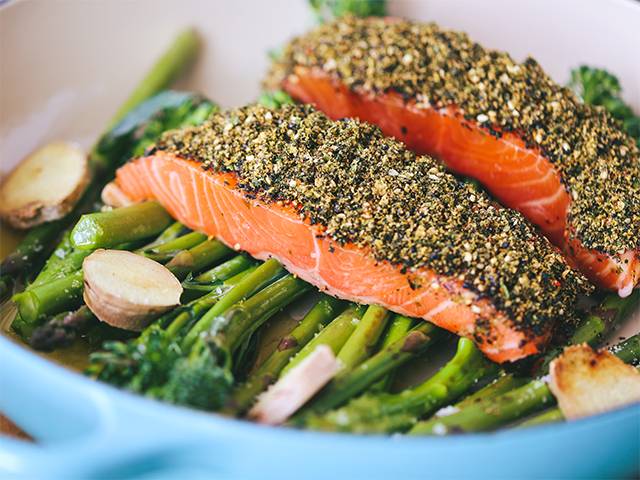5 tips and tricks to cooking salmon so itʼs perfect every time

If youʼre new to cooking or not super confident in the kitchen, salmon is one ingredient that can be a little intimidating! That shouldnʼt stop you from trying though; after all, itʼs a great weeknight meal, healthy, takes minutes to cook, and can be used in many different
ways. You just have to find the method that works for you. Here are five of my tips and tricks for getting it right every time.
1. Selecting your salmon. First things first, if you want a perfectly cooked filet of fish, you need to start with the best quality produce like Tassal Tasmanian Salmon. Whether youʼre buying from the grocery store or fishmonger, always make sure the flesh of the salmon is bright and saturated in colour, with a contrast between the muscle and fat. Avoid any fish that looks dried out or wilted, and ones in packages that have a pooling of water. When you smell it, it shouldnʼt smell like much of anything but salty, ocean air too. A fishy smell means itʼs past its prime.
2. Bring it to room temperature. Before cooking your salmon, itʼs important to remember the temperature of your fish will affect how itʼs cooked. Cold salmon pulled straight out of the fridge and added directly to the pan will cause the fillets to cook unevenly. To avoid this, remove your fish from the fridge about 15 to 20 minutes before youʼre ready to start cooking, which will bring them up closer to
room temperature.
3. Keep the skin on. When cooking salmon, keep the skin on! Not only will it provide a safety layer between your salmonʼs delicate flesh and the pan, but itʼs packed with flavour and will prevent it from overcooking. Before adding your fillets to the pan, use a paper towel to pat each one dry. When the fillets are moist or wet, theyʼre more likely to stick to the pan, and the skin wonʼt crisp up as nicely.
4. Avoid overcooking it. Overcooking salmon happens all too often, but there are simple ways to avoid this from happening. One is by gently poking your finger in the centre of the fillet to test its tenderness, to see if it yields. The other is to slide a cake tester or thin piece of metal into the salmon and touch it with your lower lip. If it feels hot, your salmon is probably done; if itʼs cool or barely warm, it needs a little more time.
5. Try roasting it in the oven. When cooking salmon, most of us naturally whip out the frying pan. But one of my favourite ways to achieve a perfectly cooked salmon is by slow-roasting it. Contrary to its name, slow-roasting only takes about 30 minutes in a 130 degree oven! I like to wrap mine up in baking paper with some of my favourite herbs and aromatics - like lemon, fennel, chilli - seasoned with a generous amount of salt, pepper and olive oil.
If youʼre more of a visual learner like me, head to tassal.com.au where youʼll find a range of how-to videos with step-by-step instructions on how to cook salmon on their Cooking Techniques page.
Words by chef and Tassal ambassador, Guy Turland.
MORE





